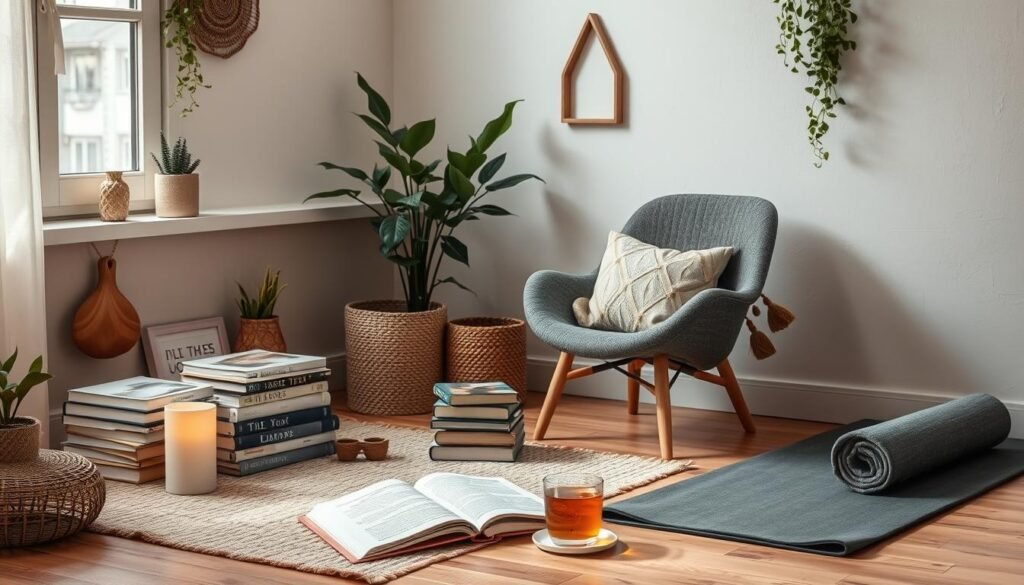About 30% of U.S. adults will face anxiety disorders during their lives. Anxiety is more than feeling nervous; it can greatly affect daily life and happiness. For some, anxiety is a disability, allowing for needed support. Knowing how anxiety acts as a disability helps people get key resources. It also builds a caring environment for those affected.
It’s key to understand the wide range of anxiety disorders, their signs, and how to manage or treat them. This piece will walk you through the different anxiety disorders, what the law says, strategies for coping, and ways to get help. For more on anxiety as a disability, check out this informative article.
Key Takeaways
- Nearly 30% of adults experience anxiety disorders at some point in their lives.
- Anxiety can significantly affect daily life and responsibilities.
- Effective treatment options include psychotherapy and medication.
- Awareness about accommodating mental health disabilities is crucial in society.
- Resources and community support are available for those coping with anxiety.
An Overview of Anxiety Disorders and Disability
Anxiety disorders include many mental health issues marked by lots of worry and fear. These issues can greatly disrupt someone’s daily life, affecting work and personal growth. By learning about anxiety disorders, we get a better understanding of their effects and how common they are.
Definition of Anxiety Disorders
These disorders are serious mental health conditions marked by constant fear and anxiety. They come in various types like generalized anxiety, panic attacks, and social anxiety, among others. Each type significantly affects a person’s life, making daily tasks difficult.
Statistics on Anxiety Disorders in the U.S.
Anxiety disorders are widespread, impacting millions worldwide. The World Health Organization found that over 301 million people had anxiety disorders in 2019. In the U.S., about 25% of workers on disability benefits are dealing with mental health issues, anxiety being a major reason. It’s also common for someone with one anxiety disorder to have another, affecting 48-68% of adults.
The Impact of Anxiety on Daily Life
Anxiety has a deep impact on daily living, making work, relationships, and personal duties hard. People with these disorders may struggle with focus, stress management, and social interactions. This often leads to feeling tired, irritable, and other symptoms, lowering life quality.
| Aspect | Details |
|---|---|
| Global Prevalence | Over 301 million individuals had an anxiety disorder globally in 2019 |
| Disability Benefits | 25% of workers receiving disability benefits qualified due to mental health conditions |
| Concurrence Rate | 48-68% of adults with one anxiety disorder have another concurrent disorder |
| Indicators for SSA Disability | Must exhibit at least 3 symptoms such as restlessness, fatigue, and difficulty concentrating |
| Accommodations at Work/School | Flexible scheduling, leave for therapy, workspace modifications, and mental health resources |
Understanding the Legal Definition of Disability
The laws about disabilities in the United States have changed a lot. The Americans with Disabilities Act (ADA) is essential in this change. Passed in 1990 and updated in 2008, it broadly defines disability. It says mental health issues, like anxiety, are just as limiting as physical problems.
The Americans with Disabilities Act Amendments
The amendments to the ADA made the definition of disability wider. Now, people with anxiety disorders get the same rights as those with physical challenges. According to the ADA, a disability is something that greatly limits one or more major life activities. Activities such as working, walking, or concentrating are included.
Criteria for Determining Disability
The ADA sets criteria to decide if someone is protected. The criteria include:
| Criterion | Description |
|---|---|
| Substantial Limitations | The impairment must significantly hinder the individual’s ability to perform major life activities. |
| Duration and Severity | The condition should be long-lasting and severe enough to impact functioning. |
| Individual Assessment | Each case must be evaluated on its specific context and effects on the individual. |
Workers with anxiety disorders may get help at work. This can be counseling, therapy, and stress management. It’s the law that employers must treat everyone fairly, without discrimination. For serious cases, some might get Social Security benefits. They have to show how their anxiety affects their daily activities. The ADA covers both physical and mental health conditions. This shows how important it is to recognize mental health in discussions about disability.
For those dealing with adjustment disorders, early help is key. It’s good to seek support from mental health experts. For recovery and managing their conditions, assistance is vital. You can learn more about this here.
Types of Anxiety Disorders
Anxiety disorders include different types, each with its own symptoms and challenges. It helps to know these types to recognize them and find ways to cope. Here are some common categories.
Generalized Anxiety Disorder (GAD)
People with Generalized Anxiety Disorder feel worried or afraid constantly. This can last for months or even years. Such long-term anxiety can lead to more problems in thinking, physical health, and behavior, affecting daily life.
Panic Disorder
Panic Disorder causes unexpected panic attacks. These can happen a lot or just a few times a year. The attacks bring intense fear or discomfort suddenly, often without a clear reason, and can be very upsetting.
Social Anxiety Disorder
Social Anxiety Disorder, or social phobia, is when someone is very afraid of being judged by others. This fear can stop them from doing normal things like working or going to school.
Specific Phobias
Specific Phobias are very strong and unreasonable fears of certain things or situations. Examples are fear of heights or crowded places. People might avoid these things, which can make their life harder. Often, they react more strongly than the actual danger would suggest.
Living with Anxiety as a Disability: Coping and Treatment
Living with anxiety as a disability can be tough. It often means feeling sad about how things used to be. People go through stages of acceptance and grieving. They may feel different emotions as they get used to this new way of life. This can make doing everyday things harder.
Acceptance and Grieving the Loss of Normalcy
The journey to accept an anxiety disorder is very personal. People often think about how their lives were before. This leads to grieving for what was lost. Going through this is important for healing. It helps people understand how to deal with their feelings. By acknowledging these feelings, they can start to find new ways to handle anxiety. These new methods help them face life’s challenges.
Adjusting Everyday Life and Responsibilities
Adapting to daily life means changing routines. It’s key to find a good balance between what you need and what you must do. Using mindfulness, planning carefully, and taking breaks helps a lot. It’s about learning to live with anxiety, not getting rid of it. Having supportive friends or getting professional help makes a big difference too.
| Strategy | Description | Benefits |
|---|---|---|
| Mindfulness | Practicing present-moment awareness to reduce stress. | Enhances emotional regulation and reduces anxious thoughts. |
| Structured Routines | Creating predictable daily schedules. | Increases a sense of control and reduces feelings of anxiety. |
| Regular Breaks | Incorporating short breaks into daily tasks. | Prevents burnout and promotes mental clarity. |
| Support Networks | Connecting with support groups or counseling. | Provides emotional support and shared experiences. |
By accepting and adjusting, people with anxiety can reshape their lives. Grieving what was lost helps move towards acceptance. This creates a solid base for growth and change.
Symptoms and Their Impact on Functionality
Anxiety disorders disrupt everyday life with a variety of symptoms of anxiety disorders. People might feel their heart beating faster or struggle with sleep. These signs matter a lot. They affect how someone acts at work and with friends.
Common Symptoms Associated with Anxiety Disorders
Here are some symptoms:
- Rapid heartbeat
- Excessive sweating
- Trembling or shaking
- Muscle tension and restlessness
- Stomach upset and gastrointestinal issues
- Difficulty concentrating and insomnia
Spotting these signs early is key. It helps start handling anxiety better. You can learn more about these symptoms here.
Effect on Work and Relationships
The impact on functionality really changes things. Anxiety might make doing well at work hard. It can even hurt friendships. Worries of being judged may cause someone to pull away from others. This can make loneliness worse.
At work, anxiety might mean less gets done or deadlines are missed. It’s tough to stay efficient and keep up good relationships.
Long-Term Consequences of Untreated Anxiety
Not dealing with anxiety has big risks. It can lead to depression, addiction, and more. A person may always feel scared. This can mess up many parts of life.
It’s important to handle anxiety correctly. With the right help, like therapy, a person can start to feel better. They can get back to living well.
Coping Strategies for Managing Anxiety
Effectively managing anxiety is personal and different for everyone. Various coping strategies can boost how one handles anxiety, leading to better overall well-being. Let’s look at helpful coping methods, professional therapy, and self-help tips.

Effective Coping Mechanisms
Adopting the right coping strategies can change how we deal with anxiety. Here are some common techniques:
- Mindfulness Meditation: Focuses on the current moment to lower stress and anxiety.
- Physical Activity: Exercise releases happy chemicals, helping mood and anxiety.
- Animal Interaction: Being with pets reduces stress chemicals and helps blood pressure.
- Journaling: Writing down thoughts brings clarity and emotional release.
Professional Help: Therapy and Counseling Options
Therapy offers tools for better anxiety management. Cognitive-Behavioral Therapy (CBT) changes negative thoughts and actions that fuel anxiety. Other therapy choices include:
- Dialectical Behavior Therapy (DBT): Mixes cognitive techniques with mindfulness for emotional control.
- Exposure Therapy: Gently exposes one to stressors to build coping abilities.
- Support Groups: Offers a sense of community and shared experiences.
Self-Help Techniques and Resources
Self-help methods are vital along with professional aid. These resources are especially helpful:
| Resource Type | Description | Benefits |
|---|---|---|
| Online Support Groups | Places to share stories and tips | Helps feel less alone and supports connection |
| Mobile Apps | Tools for mindfulness and tracking mental health | Assists with everyday anxiety management |
| Reading Material | Focuses on coping methods and self-help | Improves understanding of anxiety |
Utilizing coping strategies, seeking therapy, and using self-help resources can lead to a healthier mind and better life quality.
Medical Treatment Options for Anxiety Disorders
Medical treatments for anxiety include therapies and medications. Each method is customized for the person’s needs. The goal is to lessen symptoms and enhance life quality.
Cognitive-Behavioral Therapy (CBT)
Cognitive-behavioral therapy (CBT) is highly effective for anxiety disorders. It helps identify and change negative thoughts. By learning to replace harmful thoughts with positive ones, people can see improvements.
CBT involves challenging and changing distorted thinking. This process is known as cognitive restructuring. Many find significant relief after eight to ten sessions of CBT.
Exposure Therapy
Exposure therapy is crucial for treating anxiety. It involves facing fears in a safe setting. This approach helps people slowly overcome their anxieties.
The process starts with less scary situations. Then, it moves on to more challenging ones. Facing fears helps build confidence and control over reactions.
Medication Management for Anxiety
Managing anxiety with medication is key. Options include SSRIs and SNRIs like escitalopram, duloxetine, and venlafaxine. These meds help control mood and reduce anxiety.
Some may use buspirone for ongoing relief. Benzodiazepines are for short-term use during severe anxiety. Working with doctors helps tailor the treatment to each person’s needs.
Seeking Support: Group Therapy and Support Networks
Finding the right support is key for those dealing with anxiety. Support networks help you feel like you belong. They provide coping tools and a way to connect with people who get it. Group therapy is great for sharing and learning from others.
The Importance of Community Support
Community support is crucial in managing anxiety. It’s about surrounding yourself with people who understand your struggles. This kind of support helps you express yourself and learn how to cope. Studies show that groups led by peers are especially effective for emotional and practical help.
Finding the Right Support Group
Finding a good support group is important for healing. There are many kinds, like 12-step programs for addiction or sessions with therapists. The Mayo Clinic says that groups like NAMI’s are great for connecting with people who understand. Meetings can be weekly or monthly, offering a community and resources.
Online vs. In-Person Support Networks
Online and in-person groups have different benefits. Online groups are good for those who can’t easily travel or are busy. They offer a way to connect despite the distance. On the other hand, in-person groups give you a chance to make deeper connections through face-to-face interactions. No matter the type, being part of a community supports resilience and hope.

Workplace Accommodations for Anxiety Disorders
It’s key to recognize how vital accommodations are for those with anxiety disorders. These individuals often face unique work challenges. Accommodations help them manage these challenges, enabling full participation in their roles. Understanding the request process, what’s available, and employer duties under the Americans with Disabilities Act (ADA) is crucial for both sides.
How to Request Accommodations
Starting the conversation with a supervisor or HR is the first step to request accommodations. Explain the anxiety disorder and its workplace impacts clearly. Discuss how changes like flexible schedules or more breaks might help. Putting the request in writing is a good idea for future reference.
Types of Accommodations Available
There are many types of workplace adjustments for those with anxiety disorders. These include:
- Flexible working conditions, including remote work and changed hours
- Alternative communication ways, like emails instead of talking
- Private working spaces to lower stress
- Altering job roles to avoid anxiety triggers
Such changes often cost little but make a big difference in an employee’s work life.
Employer Responsibilities
Employers must provide reasonable accommodations unless they’re too hard to implement. This means making changes to support employees with anxiety. Tools like Employee Assistance Programs (EAPs) and mental health apps can help. Educating management and HR on recognizing anxiety is also important. A supportive environment benefits everyone, cutting down on staff turnover and boosting organizational health.
Resources for Individuals Living with Anxiety Disorders
Finding the right resources for anxiety disorders is key for anyone looking for mental health support. There’s a lot of help out there, from government initiatives to non-profit groups. You can find therapy hotlines, online groups, and websites loaded with crucial info and aid.
Government and Nonprofit Resources
Government services like Medicaid and the Substance Abuse and Mental Health Services Administration are great for discovering local help for anxiety. Nonprofits, including the Anxiety and Depression Association of America (ADAA), offer a wealth of resources. The ADAA’s website helps people find mental health pros who specialize in anxiety and depression.
Therapy and Counseling Hotlines
Therapy hotlines give instant help. Here’s a list of some hotlines focusing on anxiety issues:
| Hotline Name | Availability | Contact Number |
|---|---|---|
| National Alliance on Mental Illness (NAMI) | 24/7 | (800) 950-NAMI (6264) |
| Crisis Text Line | 24/7 | Text “HOME” to 741741 |
| Substance Abuse and Mental Health Services Administration (SAMHSA) | 24/7 | (800) 662-HELP (4357) |
Online Platforms for Mental Health Support
Mental health platforms give continuous help. They offer forums and chats for people to connect and share their stories. These websites also host free webinars with experts talking about managing anxiety, offering coping tips, and discussing effective treatment methods.

Tips for Family and Friends Supporting Someone with Anxiety
Helping someone with anxiety is key in their recovery journey. Family and friends are crucial in offering understanding and support. They can help by recognizing anxiety symptoms, communicating effectively, and promoting professional assistance, creating a caring environment.
Understanding What Your Loved One is Going Through
Anxiety can show up as defensiveness, irritability, or restlessness. Knowing these signs helps understand what your loved one feels. Regular talks and personal engagement can greatly aid their anxiety management. Remember, recovery takes time, and expecting quick fixes can lead to frustration.
Effective Communication Strategies
Good communication is essential in a supportive family setting. It’s important to avoid actions that might worsen anxiety. Support means not forcing them into stressful situations. Instead, talk openly about their feelings and reassure them, which builds trust.
Encouraging Professional Help
Getting a loved one to seek professional help requires sensitivity. Know the care they need and connect them with the right resources. Show concern and remind them that support is available. Educating oneself on mental health can reduce stigma and encourage them to get help.
Conclusion
Living with anxiety is a major challenge. It greatly affects daily life and overall happiness. Recognizing anxiety as a real issue is key. It deserves kindness and understanding.
Treating and coping with anxiety helps people live well, despite challenges. Mental health is important; we shouldn’t shame it. Open talks help with acceptance and support.
Support networks are crucial. Families, friends, and experts help those with anxiety. They provide care and resources. This creates a positive space for recovery and strength.
Everyone needs to feel cared for, especially if they have anxiety. As our view on mental health grows, continuous talks are important. They help us understand and accept anxiety better.
Knowing that anxiety is real helps everyone. It leads to better ways of coping and treatment. Together, we can fight stigma and raise mental health awareness.